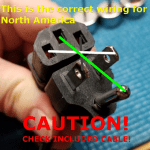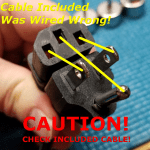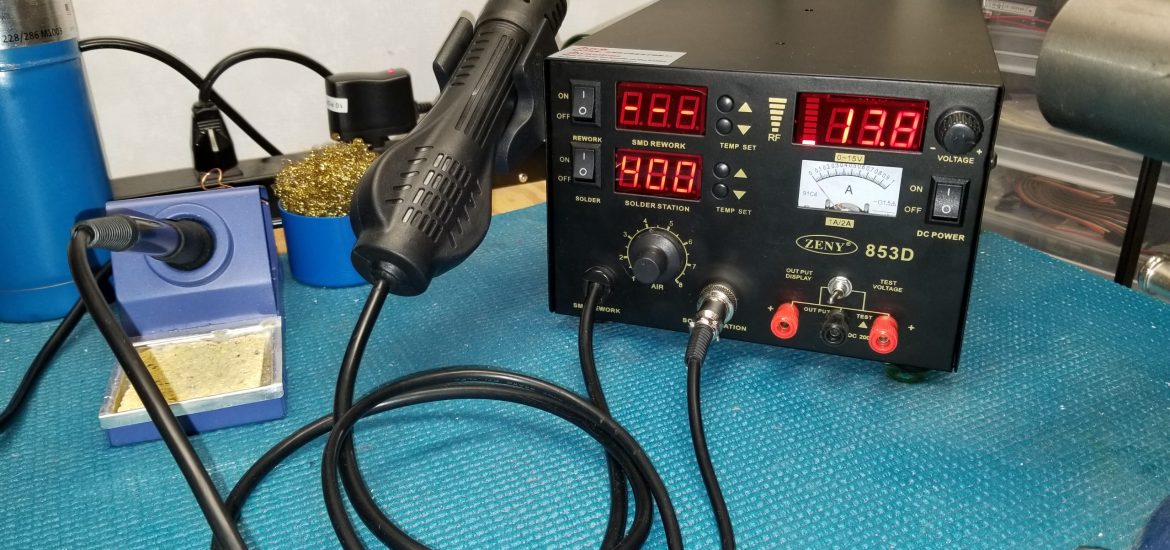Great Value/3-in-1 Solder Station
First, a Safety Caution!!


The included cable with my unit was wired incorrectly for North America, and could result in the unit being powered despite being turned off, or the fuse being blown. This could result in exposure to electrical shock! Recommend checking your cable against the included images, and replacing if you find yours is wrong. For locals, if you are unsure, or need a correct cable, contact the club and we will see if we can help. Thanks to Mark (K3JRT) for the warning.
Review
I’ve recently began building and soldering much more than what my simple Radio Shack 30 watt soldering iron would handle and figured it was about time that I got a little more serious about the tools I was using. I began researching soldering stations and what is currently available. Although the Hakko and Weller stations get great reviews, my budget and skills couldn’t really justify $200+ for a soldering station. So, I kept looking, and found some good reviews on this Zeny 853D – Solder and Hot Air Rework Station. For under $90 (as of the posting of this review), I decided it was worth a shot.
I’ve had the unit now for a little over a year, and have absolutely loved it. Maybe it’s just me getting used to something a little better than the old plug-in style irons, but this unit has made a significant difference in the quality and enjoyability (is that a word?) of my recent projects.
Each of the components (Soldering Iron, Hot Air Station, and Power Supply/Voltmeter) are individually powered on by rocker switches on the front panel. A main rocker switch on the rear, integrated with a main fuse, allows power to be turned off for the entire unit.
The Zeny 853D includes the ability to regulate your selected temperature for both soldering iron and hot air stations. The soldering iron showed reaching soldering temperature of 410 within 22 seconds, and testing against 60/40 solder showed it was ready. This is a big contrast from my previous experience with normal old plug in soldering irons, and has been a great feature against my inability to wait. Comfortable handles and adequate cord length (32 inches) for both soldering iron and hot air gun allow one to use the unit for extended duration. The soldering iron handle gets a little warm, but was never uncomfortable to use. Tip changes for the iron are very easy, but I do suggest waiting for the unit to cool first.
The hot air gun gets to temperature quickly as well, and includes a feature to protect the heating element. While leaving the switch on for the hot air gun, one should doc the gun when not in use so the station will sense the gun, and turn the heating element off while the fan stays on. This allows the unit to cool down and protect the heating element. Once the temperature returns below 100 Celsius, the fan will turn off. Once the fan turns off, you can safely turn off the hot air station with the toggle switch. The hot air rework station gives me the ability now to try my hand at surface mount projects, and the added feature of desoldering components from recycled electronics in bulk! Simply turn over the old board, heating the elements from the soldering side with the component toward the workbench, and work the hot air around the area you with to desolder. When you see the solder starting to melt, tap the board against the workbench a few times, and collect all of the components that fell. This works well with very little practice, but don’t hold the hot air in one location for too long or you may end up smoking the board!
Use of the DC power supply/voltmeter is OK for those that don’t already have an adjustable power supply, or if you needs something small in addition to what you already have. The unit will deliver 0.1 to 15.5 volts with up to 2 amps (or so the specs say, I didn’t try to see what it would do), which should work for lots of small radio projects. It also includes an analog ammeter to indicate the current draw. If you want to use as a DC power supply, I suggest making your own or buy test leads with alligator clips or something else more useful than the supplied probes. Use of the unit as a voltmeter shows detail to a tenth of a volt. This may work for you a little better than for me as I have plenty of multimeters that can handle the job, and didn’t really need this feature. I did test the unit against a know good multimeter on a 9v battery, and both indicated the same voltage.
The Bad
The power cord included with mine was wrong (see the warning at the top of this posting). This is something that needs to be addressed by the manufacturer. For those that like to use Fahrenheit , you’re just out of luck, as the temperature settings are only available in Celsius. The included probes for power/voltmeter didn’t sink far enough into the jacks to my liking, so I simply cut the plastic around the probe plugs to allow a deeper connection (see pictures for details).
After about one year, the soldering element in the iron stopped heating. Simple replacement right? Well, the larger problem became the search for a soldering iron replacement or element that would work. After several attempts were made at purchases and returns (all under $10), I contacted Zeny on Amazon. They directed me to the actual replacement element, and even sent me a replacement iron on their dime (I didn’t ask for this as I assumed after a year, it was a consumable that I should replace myself). This was a nice surprise as contrast to customer service from other vendors from China that I have experienced. If you wish to purchase a replacement element (I can’t find the whole soldering iron listed), search for the HAKKO A1321, Solder Iron Heating Element. Mine was acquired from eBay for under $8, delivered within 5 days from a US warehouse. The problem with the others is that the temperature sensor is out of spec to use with the Zeny 853D. Replacement of the element will be covered in a future article if you need help (will provide a link here when available).
My Recommendations
I would highly recommend the Zeny 853D for anyone that wants to get a little more serious about their workbench builds and doesn’t want to spend the big bucks. The DC power supply is a great feature for powering small projects and not taking up any more room on the bench. If you decide this station is for you, make sure you do the following mods:
- CHANGE THE POWER CORD!
- Cut the plastic around the probe banana plugs if you want to use them
- Get something useful for leads if you’re going to use the DC power supply
- Remove the handle from the top if you wish to stack items on top
- Keep a spare soldering iron element on hand
Specs
Dimensions – 13.5 x 11 x 8.3 inches (more space needed for workbench)
Weight – 8.85 pounds
Includes:
3 in 1 Soldering Station Unit
Hot Air Gun
Soldering Iron
Soldering Iron Stand
11 Soldering Iron tips
Sponge
Desoldering Wick
Hot Air Holder
4 Nozzles for Hot Air
DC Probes
IC Extractor
Manual
Links:
Amazon listing for the Zeny 853D (no longer available)
Update 5/26/2021:
Additional information on the Zenny 853 was given to me by Steve, K7LZJ. Seems he’s had some fun in modifying a unit for additional voltage in the power supply, and a few other recommendations for usability.
Links here:
Zeny 853D adjustment and power supply upgrade
Zeny 853D schematic
Additional content about the Zenny 853D
Thanks Steve!
